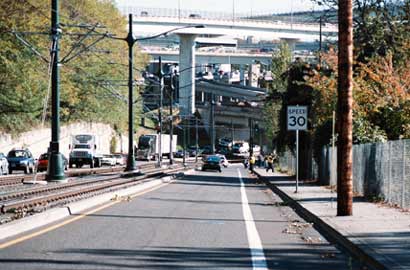
with a reporter at the
Courthouse this morning.
(Photo © Jonathan Maus)
This morning, Multnomah County Senior Deputy District Attorney Chuck Sparks (in photo) released his report on the case of Brett Jarolimek, who died on October 22 after colliding with a garbage truck on Interstate and Greeley.
After an in-depth investigation that included several trips to the scene, video footage from the top of the hill, and multiple interviews with the truck’s passenger and with witnesses who saw the entire collision take place, Sparks’ has determined that the garbage truck driver, Bryan Lowes, did not, “show conduct rising to the level of criminal negligence”.
I sat down with Sparks outside his office this morning and he explained how he arrived at this decision.
Primarily, he said, this case had to do with several unfortunate converging factors; the contours of the road (which presented visibility issues), the blind spot and functioning of the mirrors on Lowes’ truck, and how Jarolimek’s speed and lack of visibility coming into the turn would have prevented him from having time to react to the situation.
According to Sparks’ report, footage from a Kaiser Hospital video camera at the top of the hill confirms that the truck passed Jarolimek near the intersection of Interstate and Fremont (near Overlook Park, about one-quarter mile from the collision).
Lowes maintains (and Sparks believes him) that he did not notice passing Jarolimek at that time.
Using timestamps on the video, the investigating officer, Chris Johnson, estimated Lowes’ speed at the top of the hill to be 31-32 mph (the speed limit is 30) and Jarolimek’s speed at 21mph. After this point, Sparks reports that the road goes slightly left, then straight for 200 yards downhill at a “significant grade” of 7.4%.
The report notes that, “Officer Johnson noted that Mr. Jarolimek apparently gained speed as he entered the downhill grade.”
At the end of the straight downhill section is the right turn onto Greely (where the collision occurred), which Sparks describes as “deceptively abrupt, and a vehicle making this turn is not fully visible from the 200 yard straight section above.”
Following Lowes’ truck (in a Nissan Armada) were Delores and Steven Harris. They say that Jarolimek passed them at the “stop here on red” sign located just north of the collision (at the point where the road begins to veer to the right).
[In the photo below (it was included in Sparks’ report), the “stop here on red” sign is located where the people with yellow jackets stand.]

(Photo: District Attorney’s office)
According to the report, Mr. and Mrs. Harris saw the entire collision unfold. From the report:
“Mr. Harris said he knew the bike was going to hit the garbage truck when it passed them, and that “the bike passed us not slowing down enough.” Mr. Harris told Officer Johnson that there was nothing the truck driver could have done to avoid the collision.”
The report also confirms that the truck did have its turn signal on and that it slowed “to a near stop” as it approached Greeley. Lowes told an officer on the scene that, “he did not see a bicyclist in the bike lane, but knew about the bike lane and checked the lane via his mirrors before making his turn.”
Here is what the report says about the truck’s mirror:
“Investigators found that the mirrors, as positioned post-collision, did not give a good view of the area behind the truck from a normal driving position. Specifically, while sitting in the driver’s seat with hands on the wheel, Officer Johnson had to move forward up to 8 inches in order to get a proper view.
When asked about this, Mr. Lowes [the driver] said that when his passegner used the door on which the mirror is fastened, the mirror’s position would change and he would then have [his passenger] adjust the mirror back to the proper position…he said that is was in a proper position before the collision.
Officer Johnson noted that the mirror was held in position in part by a bungee cord and a wire…”
During our conversation this morning, Sparks explained that because of the way the road curves, and given the “rather narrow view” of the truck’s main mirror, it is likely that Jarolimek would not have been viewable at the moment Lowes checked before making his turn.
The report also says that Jarolimek’s tire left a 36-foot long skid mark leading up to the point of impact and that his speed was likely 22-28 mph going into the collision (that equates out to 32-42 feet per second). Those facts prompted Sparks to write:
“This rate of travel gave little time for Mr. Jarolimek to react to the situation as it unfolded before him, especially since the roadway curved into the accident scene, interfering with his view from above…”
And then Sparks made a point to emphasize to me what he wrote next:
“While the curve and some visual clutter made it hard for a cyclist to see ahead into the intersection, a driver in the curve would also lose a clear view back up the 200 yard straightaway into the bike lane since the mirror’s view changes with the vehicle’s position as it rounds the curve…making it harder, if not impossible, to see a bicyclist in the upper 200 yards, especially one traveling quickly.”
Unfortunately, in Sparks’ analysis, both the truck and Jarolimek were momentarily partially out of each other’s view and, “neither person had adequate time to perceive and react to this situation.”
From Sparks’ conclusion:
“From above, his truck was not completely visible to Mr. Jarolimek as the latter came down the 200 yard straightaway toward the intersection, nor apparently was Mr. Jarolimek visible to him in his mirrors. Mr. Jarolimek entered the scene of the collision at 22-28 mph and was clearly surprised by the presence of the truck starting to turn. He immediately braked and skidded…but was unable to avoid the truck.”
You can download Sparks’ full report and memo here. (800KB, PDF)

